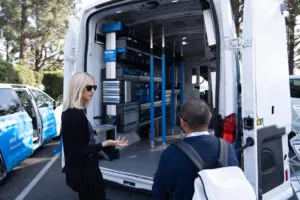Over 500 participants attended this year’s Fleet Forward conference, which sparked some great discussions about market trends, successful strategies, and challenges on the road ahead. Revolv also had the honor of participating in a main ballroom panel on Updating Fleet Policies for the EV Era, where we discussed the future of fleet management in an evolving landscape. The following are the main themes we heard across the three-day event:
- Electrification driven by savings, not mandates: We heard that more fleets are moving to electric not solely because of mandates but because of the cost benefits. Several fleet leaders shared how focusing on smart site selection, landlord relations, routes, incentives, and optimizing the gap between diesel and electricity costs is generating economic success, especially in the 2-5 vehicle class range. It was shared that when fleets struggle with deployments, it’s typically not that the technology isn’t working, but that the application of the technology was misapplied.
Range advances in the spotlight: We participated in the Ride & Drive sessions, which showcased the strides EVs are making in range. The latest models from Ford, Stellantis, and GM are achieving ranges of up to 300 miles, which comfortably supports most medium-duty fleet needs, with Geotab data showing that 81% of ICE vehicles in this class drive under 150 miles daily.
- State-level incentives matter: Policy experts shared that while federal policies remain uncertain, states are stepping up with infrastructure incentives that can cover up to 80% of construction costs; however, these won’t last forever as program budgets are static. We heard from fleets who fully upgraded and electrified sites now and took advantage of today’s infrastructure incentives for future vehicle deployments.
Overcoming interconnection barriers with smart planning: Conversations with local utilities shared that while interconnection challenges exist, smart load control solutions can streamline both cost and timeline for projects. With over 3,000 electric utilities in the U.S., each with unique interconnection requirements, a collaborative approach with utilities and load controls is a viable solution for faster implementation.
- Programmatic infrastructure builds for future-proofing: Fleets are adopting a programmatic approach to building EV infrastructure, aiming to future-proof sites for long-term scalability. By designing infrastructure with flexible capacity and modular components, fleets can accommodate more vehicles and higher power demands over time without major overhauls. This proactive approach reduces costly retrofits and ensures that facilities can evolve in step with both fleet growth and advancing technology. We’re excited to discuss how these insights can help your organization navigate the transition to a more sustainable and efficient fleet. Let’s connect soon or have us help you with a free electrification study.

 Range advances in the spotlight: We participated in the Ride & Drive sessions, which showcased the strides EVs are making in range. The latest models from Ford, Stellantis, and GM are achieving ranges of up to 300 miles, which comfortably supports most medium-duty fleet needs, with Geotab data showing that 81% of ICE vehicles in this class drive under 150 miles daily.
Range advances in the spotlight: We participated in the Ride & Drive sessions, which showcased the strides EVs are making in range. The latest models from Ford, Stellantis, and GM are achieving ranges of up to 300 miles, which comfortably supports most medium-duty fleet needs, with Geotab data showing that 81% of ICE vehicles in this class drive under 150 miles daily. Overcoming interconnection barriers with smart planning: Conversations with local utilities shared that while interconnection challenges exist, smart load control solutions can streamline both cost and timeline for projects. With over 3,000 electric utilities in the U.S., each with unique interconnection requirements, a collaborative approach with utilities and load controls is a viable solution for faster implementation.
Overcoming interconnection barriers with smart planning: Conversations with local utilities shared that while interconnection challenges exist, smart load control solutions can streamline both cost and timeline for projects. With over 3,000 electric utilities in the U.S., each with unique interconnection requirements, a collaborative approach with utilities and load controls is a viable solution for faster implementation.